SELECTIONS
WINTER 2023 IN THIS ISSUE




With each new year often comes renewed focus. Have you reviewed your operational goals? Does your genetic strategy need a refresh? Are you working with Select Sires to leverage the cooperative’s services and genetic resources to boost your bottom line?
The influence of health and wellness traits stepped into the spotlight in 2022. The negative impacts of mastitis are well known; it is one of the leading reasons for involuntary culling and it’s also the most costly disease in the dairy industry.
How are you protecting your cows and your balance sheet from mastitis?
Unfortunately, mastitis resistance isn’t a priority for most A.I. companies and doesn’t receive adequate emphasis in selection indexes. Many believe that management is the best way to lower mastitis events. Yes, you can make great improvements to manage environmental mastitis. However, if your cows are genetically susceptible to mastitis infections, stronger teat dips and cleaner bedding isn’t going to move the dial.
The unfavorable genetic correlations between production traits and mastitis implies that herds with an emphasis on 305-day milk yield will experience deterioration in udder health. Despite the low heritability of udder health traits, genetic variability exists for these traits and there’s opportunity to select elite genetics with strong production and mastitis resistance, all while improving animal welfare.
The best indexes for production and health are Zoetis’ Dairy Wellness Profit Index® (DWP$®) and Select Sires’ Herd Health Profit Dollars™ (HHP$™). In both indexes, there is approximately 15% emphasis on mastitis resistance. Net Merit (NM$) offers a mere 3% to mastitis resistance traits. DWP$ and HHP$ are more modern wellness and profitability indexes to build better cows for your future. Select Sires is also emphasizing these health traits in sire procurement and development, including within the NxGEN® lineup.
You can read more about the influence of health and wellness traits and the momentum behind the NxGEN lineup throughout this edition of our Selections magazine.
In late January, Select Sires announced the creation of Low Carbon Technologies, LLC, a new enterprise to serve beef and dairy farmers who are looking to document, verify and improve their operation’s carbon footprint and overall sustainability.
Our farmers are looking for ways to both prove and improve how they are producing food sustainably. Through Low Carbon Technologies, we intend to be their partner in increasing the value of environmental stewardship to their operations. Low Carbon Technologies will certify cattle regardless of the source of genetics. Longer term, the enterprise intends to expand sustainability assessments to other agriculture goods. Visit www.selectsires.com/discover to learn more about this new initiative and our sustainability efforts. u
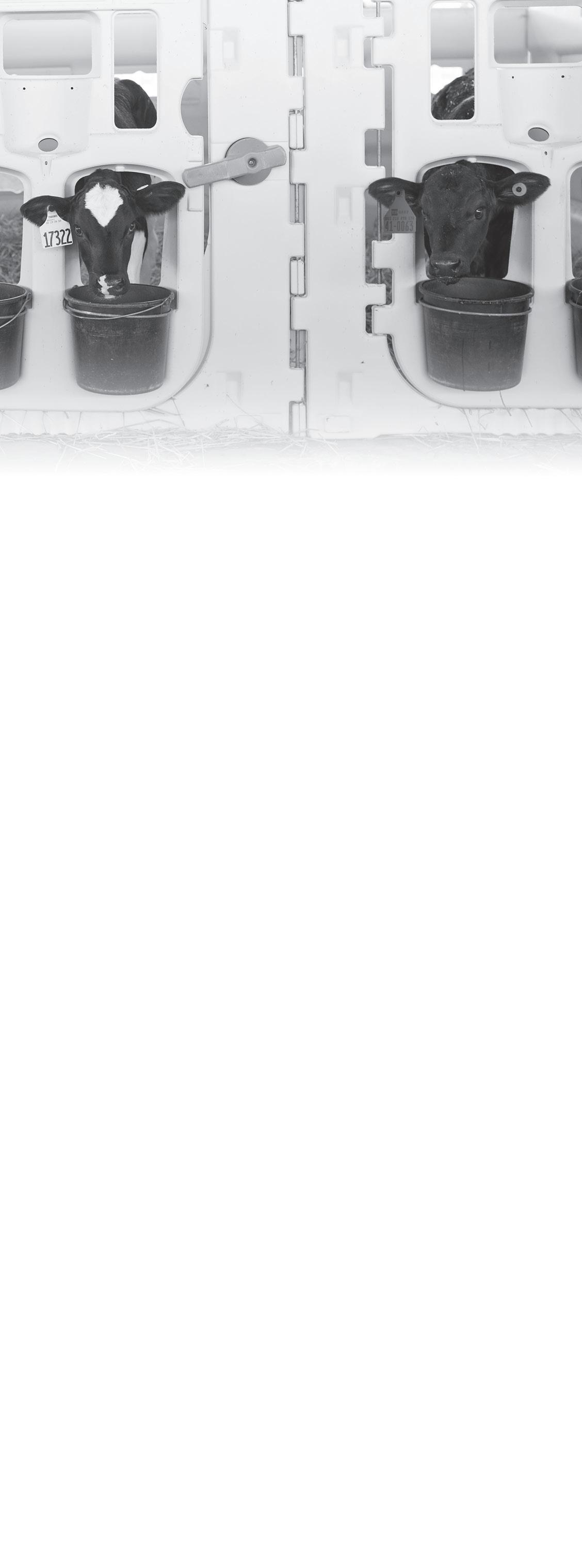
Bovine respiratory disease (BRD) is one of the most challenging obstacles calves encounter and is often the result of transporting, regrouping or environmental conditions. AccelAIRate is a nutraceutical product formulated to help support the respiratory system of young cattle. This palatable combination of natural essential oils, herb extracts, bioactive compounds and antioxidants is a complete, effective and economical solution to:
• Assist in preserving respiratory health
• Help alleviate symptoms of respiratory disease
• Aid the recovery process from respiratory distress
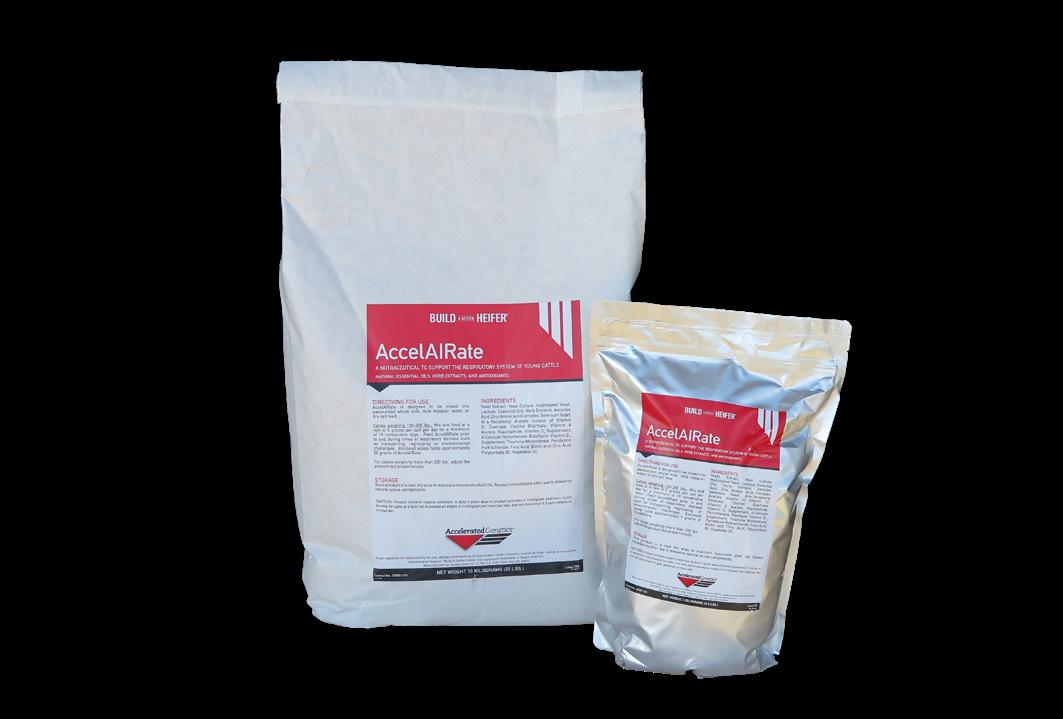
• Support overall health status
Help young cattle breathe easier, contact your representative today!
Four years ago, Tlucek put genetics in the driver’s seat and pushed down on the accelerator. Improving the herd’s genetic base became a top priority for the 2,200-cow operation. Tlucek built an ovum pick-up (OPU) facility on-farm, partnered with local veterinarians and reached out to Select Sires to train the herd’s independent technician to perform embryo transfers (ET). Then, he developed an aggressive genetic strategy using high-profile sires and enrolled in NxGEN® for early access to the most elite genetics.
“I’ll be transparent and share that our genetics were below average just a few years ago,” said Tlucek. By combining elite genetics with the herd’s ET strategy, the herd has experienced exceptional genetic advancement. Tlucek added, “We haven’t changed our management. We haven’t changed our facilities, and yet, we have become more profitable with better cows.”
The increased focus on genetics has put Snake River in the fast lane in just a few generations. Tlucek shared that he’s changed the dairy’s business model because the herd had an opportunity to sell elite young cows. Entry into this new market influenced his breeding strategy and
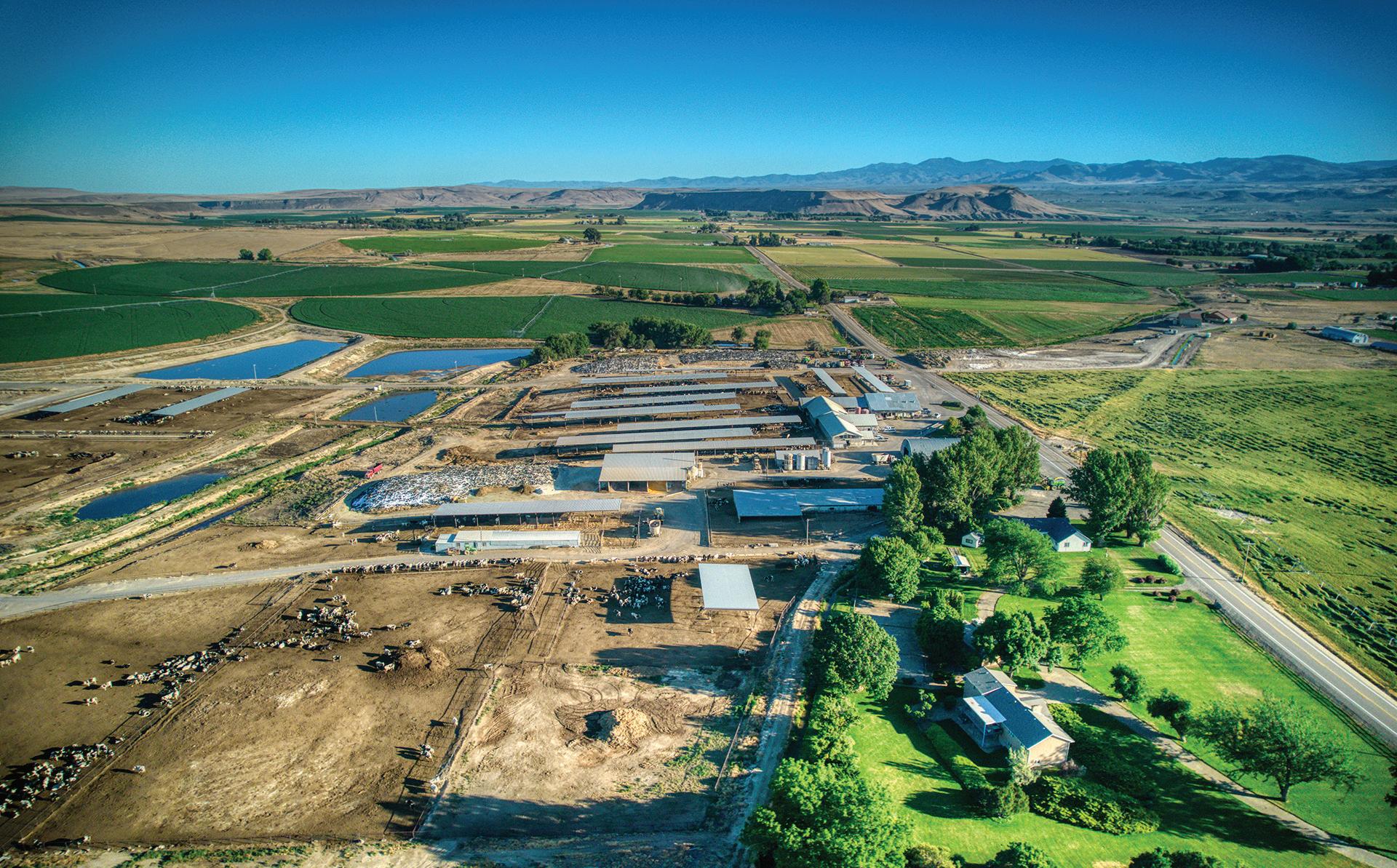
the lactation makeup of their herd, but it was a welcome bonus to the operation’s bottom line.
Tlucek recently stopped using beef semen on the herd’s bottom quartile cows and is currently finishing the final group of beef x dairy steers. Tlucek said, “We needed more recips! We had this new market to sell young cows and we needed more uteruses for embryos – the shift just made sense.”
Utilizing Zoetis CLARIFIDE® Plus genomic test insights, Tlucek has developed a very aggressive strategic breeding program. Today, 22% of both cow and heifer groups are confirmed pregnant with embryos, most of which are harvested on-farm from the herd’s best cows. For the rest of the herd, 17% are confirmed pregnant with conventional semen while 61% are confirmed pregnant from sexed semen.
The need for more recipients has influenced the herd demographics. Currently, 40% of the herd is first lactation cows, while 30% are in their second lactation and 30% are third lactation and greater. Tlucek’s next move will be to grow the percentage of older cows by emphasizing health traits, specifically mastitis resistance.
“If you’re not on a track for improvement, you’re going out of business,” said Kevin Tlucek, owner at Snake River Dairies in Melba, Idaho.
INCREASE COMPONENTS No. 1

Tlucek was blunt in saying that boosting milk production is not an explicit goal for Snake River. They are laser focused on components. In fact, feed costs and component yields are his main metrics for measuring profitability. He believes that the best way to increase fat and protein is a combination of nutrition and genetic selection and puts heavy emphasis on Combined Fat and Protein (CFP) in his selection index. His approach is paying off with recent herd tests at 4.8-5.0% Fat and 3.4-3.5% Protein.
Mastitis resistance comes in as a close second on his list of priorities. Sires are vetted using Somatic Cell Score (SCS), CDCB Mastitis Resistance and Zoetis Mastitis Resistance. Tlucek said, “I know that older cows are more profitable in the long-term, but they also have more health issues.” He went on to explain that mastitis events flare up between the second and third lactation. Sure enough, the quartile analysis shows those older cows flagged for mastitis events are high for SCS and low for both mastitis resistance evaluations.
Reproductive efficiency is third on Tlucek’s hot list. Especially with the herd’s embryo strategy, fertility traits are of high importance and heavily considered in the selection criteria.
First Lactation Cows - Genomic Data for CDCB MAST
No. 2 BOOST MASTITIS RESISTANCE No. 3

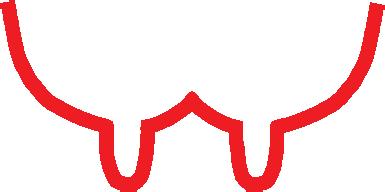
Second Lactation Cows - Genomic Data for CDCB MAST
*$444/cow mastitis cost reflects research cited in Preventative Veterinary Medicine, “The cost of clinical mastitis in the first 30 days of lactation: An economic modeling tool.”
Second Lactation Cows - Genomic DWP$® Average

Tlucek’s exclusive use of NxGEN sires has accelerated the herd’s success. Having enrolled in similar programs from other genetic companies, he shared that he prefers NxGEN’s genetic offering and realistic contractual obligations.
He currently has pregnancies from 30 different sires, most of which are NxGEN graduates or current NxGEN superstars. A few of Tlucek’s favorite sires include: 7HO15977 HAYK, 7HO16276 SHEEPSTER, 14HO15926 VAN GOGH, 14HO16082 FRAMPTON and 14HO16391 EASTON.

“Like most things in the dairy industry, it takes a little bit of time to see the payoff,” said Tlucek. “But I believe that investing in genetics pays you back many times over.”
Proof of his success? There are currently six heifers with the Snake River prefix that are more than +3000 GTPI® and 120 heifers over +2900 GTPI. The
“The cost to raise a heifer that’s +500 Cheese Merit (CM$) is exactly the same as the cost to raise a heifer that’s +1,100 CM$,” said Tlucek. “But that +1,100 CM$ heifer will bring your herd more profitability in the long run.”
Genetics are driving profitability for Snake River Dairies and this strategy influences the next generation of cows, as well as decision makers. Three of Kevin Tlucek’s four children are involved in the operation and his son, Isaac, is very interested in becoming a third-generation owner. Like most herds, genetic strategy and selection has evolved with time, however, an aggressive approach in just four years has put Snake River Dairies in a very competitive position. u

Snake River Dairies was founded in 1960 by Kevin’s parents, Jerry and Mary Lou. They both grew up on dairies near the operation’s current location. What began with just a few Guernsey cows has grown to today’s 2,200-cow operation. Decision makers and owners for the herd include Jerry and Mary Lou, as well as Kevin and his wife, Becky.


What’s one major transformation in the dairy industry throughout the last 50 years? 20 years? Even 10 years?
More milk, fewer cows.
When it comes to efficiently utilizing resources, feeding the world, and caring for animals, the dairy industry is already a success story in sustainability. However, often when people discuss sustainability and dairy, they immediately think of the emissions associated with dairy cows. What if we look more holistically at the cow and the management decisions made on farm that impact her in order to capture a more complete story of sustainability and the levers that can be pulled to improve sustainability?
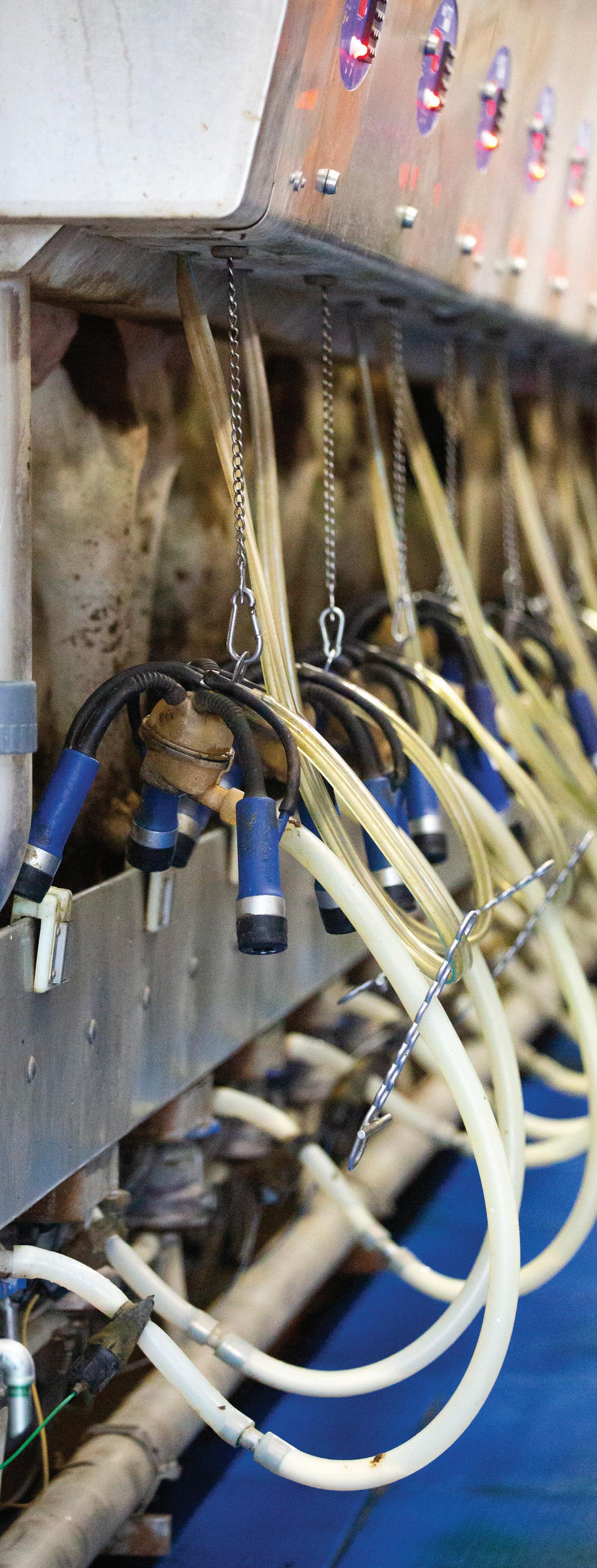
We know, because we can measure, that a cow making 70 pounds of milk each day makes less methane than a cow making 90 pounds each day. However, wouldn’t we all rather have a barn full of cows who can eat a few more bites of the same feed and make 90 pounds rather than 70? Of course! We know that the 90-pound cow is more efficient than her 70-pound cohort; she spreads her fixed inputs (feed needed to maintain life and pregnancy) over more milk, so even though she makes more methane, because she eats more, she makes milk with a smaller methane footprint per gallon of milk. As an industry, we have learned an immense amount about dairy cattle nutrition throughout the past 50 years and implemented these findings in how to feed our cows to optimize their production and therefore their sustainable production of milk. We have also spent decades focusing on long-term genetic improvement of milk production, with each generation of cows demonstrating improved milk (and milk solids) production than previous.
A lesser considered, but equally important, reason for progress in milk production efficiency is health. We can all rally around the ideas that clean, comfortable housing, prevention, early detection and treatment of disease and high reproductive efficiency are advantageous for improved performance. While there are many management levers that can be pulled to achieve improved performance, one that is becoming increasingly researched is genetic selection for health.
Over the past 25-30 years, we have started recognizing the importance of traits other than type and production in genetic selection and have started to see the impacts. In fact, since the early 1990s, when health traits including fertility were first introduced into genetic indices, we have seen a rapid improvement in reproductive performance of dairy cattle, including cyclicity, expression of estrus, and improved conception rates
compared to the decline in fertility in decades prior to this integration (Lucy, 2019). Even more recently, other health traits have been added to genetic indices and we are beginning to see these same quantifiable impacts when selecting for health traits or using indices that consider health and longevity.
We are seeing that not only can we manage for healthier, more fertile cows, but we can selectively breed for these cows; cows who are at a lower risk of mastitis, transition diseases, who have improved reproductive performance, and who will have a lower risk of being replaced by a younger animal because they are healthy and making more milk. Just as we have seen a compound impact of milk production generation by generation, we will see a compounding impact of improved health and fertility over the generations.
While a quantifiable impact of improved cow health and fertility on emissions is not available today, we do know that a cow with a case of mastitis has 6% higher emissions per gallon of milk produced than her counterparts that do not have mastitis (Mostert et al, 2019). Compound that on the herd, or over generations, and we can make large amounts of progress in our sustainability journey with healthier, more fertile cows.
Think back to our 70-pound vs. 90-pound cows. Everyone in the dairy industry, from farmers to veterinarians, nutritionists to dairy buyers, knows that healthy, well-cared-for cows make the most efficient, and therefore most profitable, milk. Let’s add to that and unite around the idea that these same cows make the most sustainable milk. One lever we can pull to improve health and sustainability is through genetic selection! u
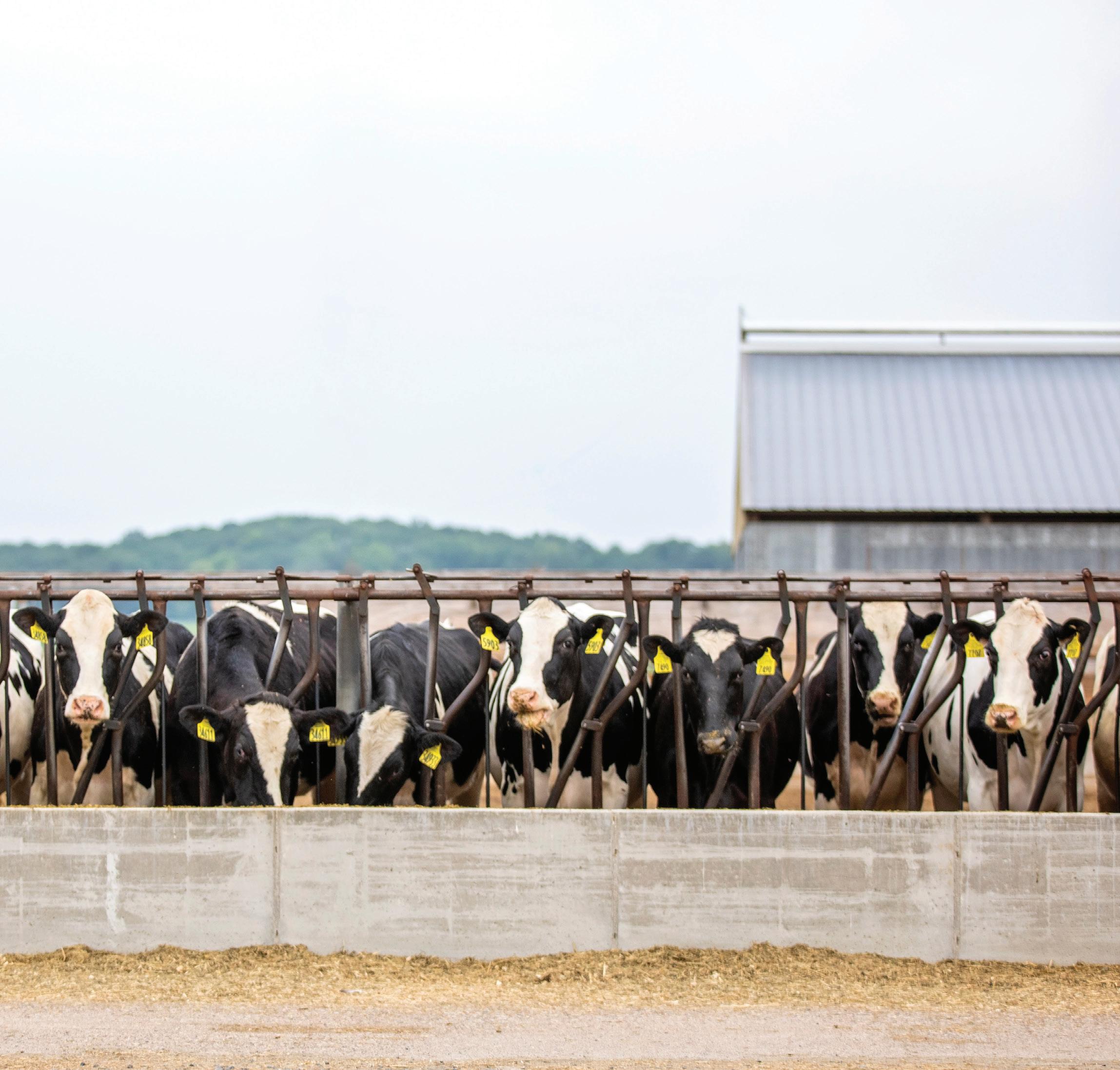
From coast to coast, dairies are calving in beautiful and profitable daughters sired by NxGEN® graduates. From the early genomic predictions, these farmers are now experiencing real results as these daughters are working hard in the milking string. The NxGEN program was designed by dairy producers, for dairy producers. Since the initial launch in 2019, NxGEN members have had early access to 108 ultra-elite sires. Four of those sires have since graduated to the daughter-proven lineup, including 7HO14250 LEGACY, 7HO14364 EISAKU, 7HO14859 MAXIMUS and 250HO14134 RENEGADE. NxGEN is a membershipbased program designed for dairies that want to drive their genetic performance to the next level.
NxGEN MEMBER: Jarrod Kollwelter, JC-Kow Farms LLC, Wis.
ABOUT THE OPERATION:
We milk 250 cows and raise 400 heifers under the JC-Kow prefix in Whitewater, Wisconsin. Our program is very focused on production, fat and protein. We topped Holstein USA’s Monthly 40,000+ Pound Production Record list in December with JC-Kow Jedi 914 at 60,010 pounds. We rely on genetics to help us meet our operational goals and the majority of our herd is bred to NxGEN sires with a growing number of our lactating cows sired by NxGEN graduates. We have 80 7HO15167 GAMEDAY heifers that we are excited about, and lots of young 7HO15821 FROST BITE calves. The breed’s No. 3 daughter for Dairy Wellness Profit Index® (DWP$®) is a FROST BITE daughter from our program!
TOP THREE GENETIC GOALS:
u Efficient, high-producing cows
u Healthy cows that breed back
u Functional type

WHY DID YOU JOIN NxGEN?
It was simple - we wanted better genetics faster. We have a flush program and we wanted to be using the absolute best genetics to move our herd forward. Our selection criteria considers TPI®, NM$, PTAM and CFP, and we find that the sires in NxGEN match our goals.
WHICH SIRE IN THE CURRENT NxGEN LINEUP ARE YOU MOST EXCITED ABOUT? 7HO16276 SHEEPSTER - he’s the total package. Production and health traits.
WHO ARE YOUR TOP PERFORMING COWS SIRED BY?
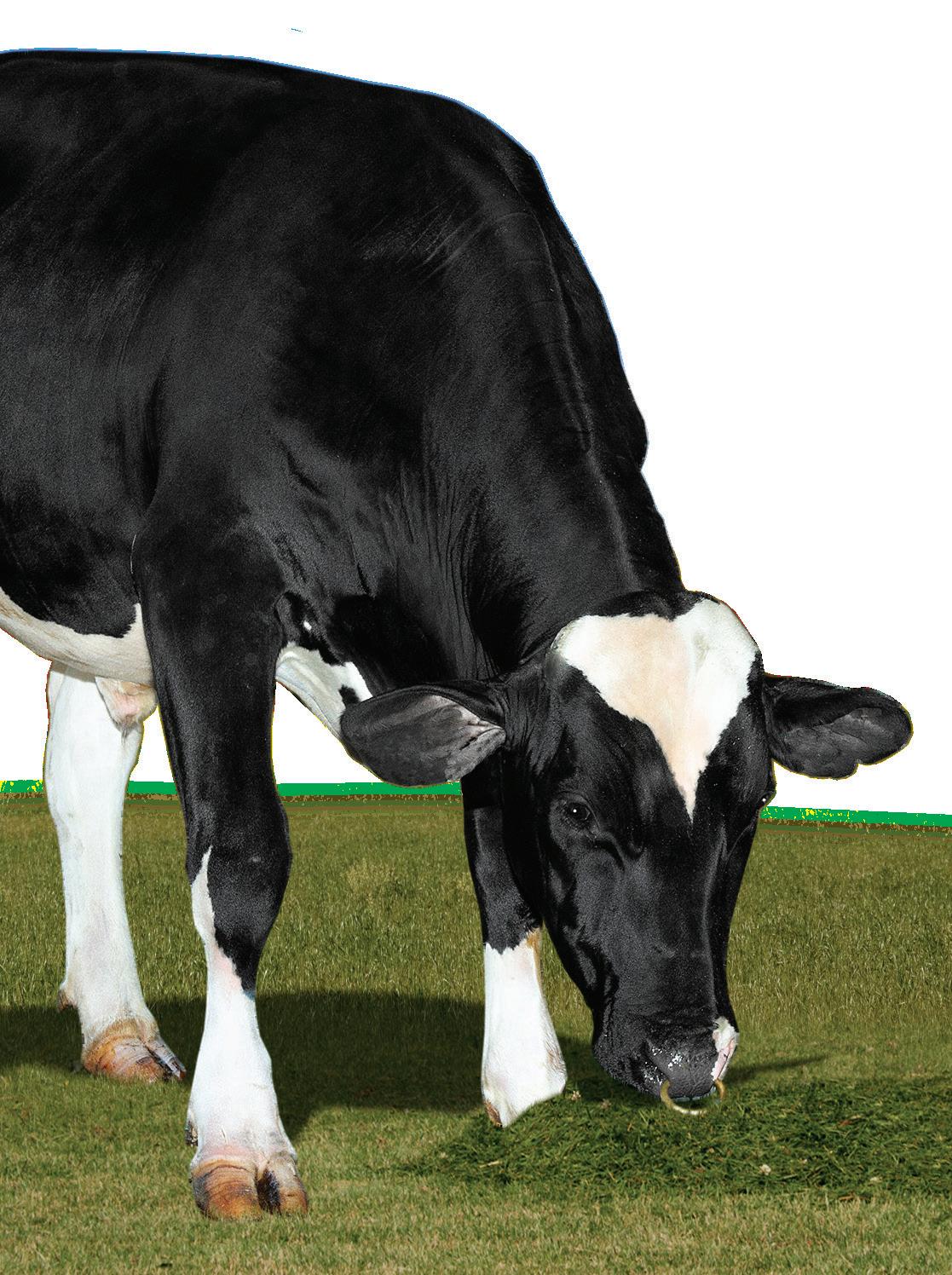
We have a lot of milking LEGACY daughters that perform very well. Our RENEGADE daughters also come to mind. They are strong cows with a lot of production power.
l-r: Wilra SSI Legacy 2013-ET (GP-82-VGMS), Wilra Farms, Inc., Nashville, Ill.; LEGACY Daughter Group, Wilra Farms, Inc., Nashville, Ill.; AOT Eisaku Honestly-ET (VG-85), Siemers Holstein Farms, Inc., Newton, Wis.; RENEGADE Daughter Group, Destiny Farms LLC, Marshfield, Wis.

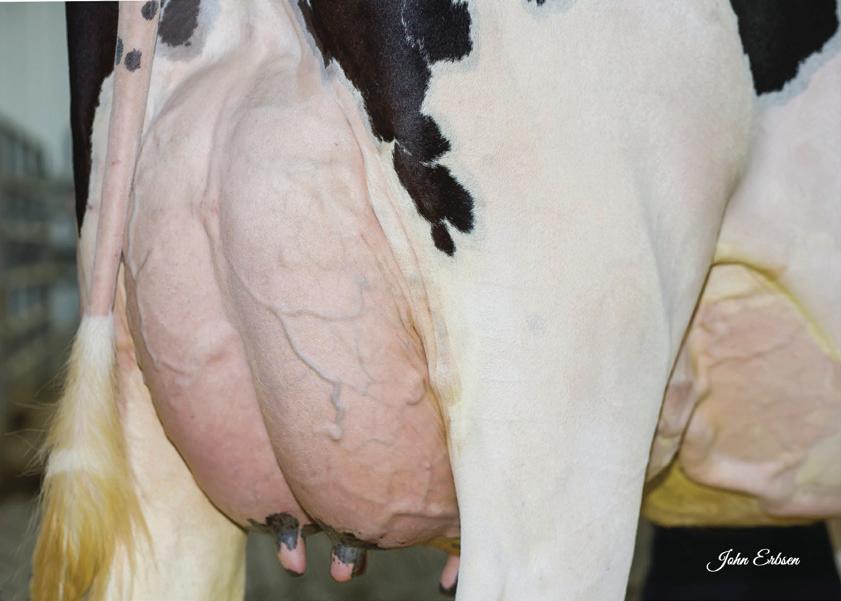
NxGEN MEMBER: Steve Buscher, Plain-Knoll Holsteins, Ohio
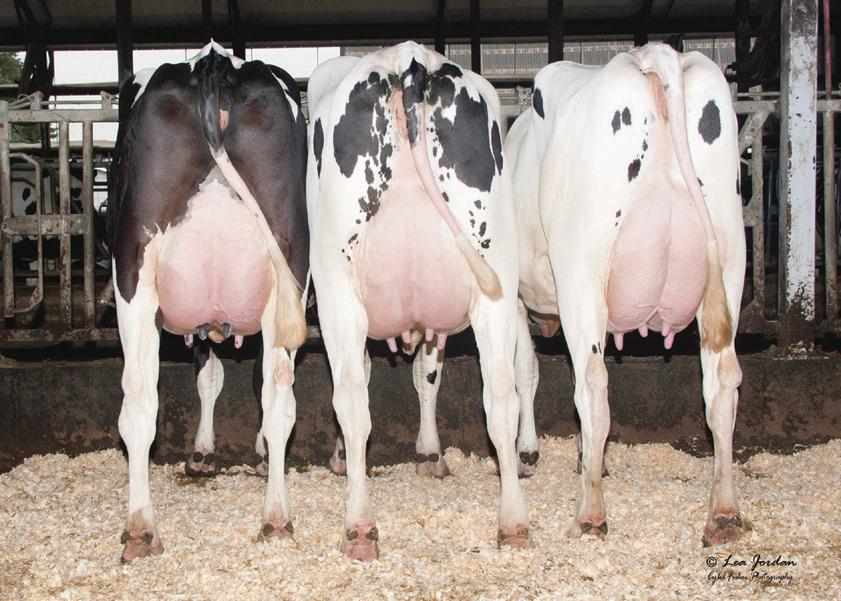

ABOUT THE OPERATION:
Plain-Knoll Holsteins is located in west central Ohio and we milk
700 Registered Holsteins. In 2016, we built a Trans Ova satellite and have a donor program made up of our highest-ranking cows and heifers. About 75% of our heifers carry embryos and we have been using more cows as of late. We have always believed in the value of top genetics and it has helped us achieve an RHA of 32,020 Milk, 1,220 Fat and 1,024 Protein, along with a low 93,000 SCC and a 34% pregnancy rate. Because of our genetic strategy and investment in the best sires, we’ve sold, on average, 30% of our herd each year for dairy purposes for the past 20 years, all without using much sexed semen.
TOP THREE GENETIC GOALS:
u Maximize production, specifically pounds of fat
u Moderate stature with adequate dairy strength, great udders and mobility
u Cows that produce high-quality milk, breed back easily and are trouble-free

WHY DID YOU JOIN NxGEN?


We joined NxGEN as soon as it was available because we appreciate the latest and greatest genetics. NxGEN provides producers opportunities to capitalize on top genetics while the cooperative maintains moderate control. This setup allows Select Sires to remain competitive and continue to develop the top genetics and in turn, provide those genetics back to us through NxGEN. As a breeder, we see how other studs have much, much tighter restrictions that only serve themselves and not the dairy producers they are supposed to serve!
WHICH SIRE IN THE CURRENT NxGEN LINEUP ARE YOU MOST EXCITED ABOUT?
The sires that best fit our breeding goals include: 250HO16074 FIGARO, SHEEPSTER, 7HO15913 KAHN, 250HO16110 LETCHWORTH, 7HO16176 WAR GEAR, 7HO15977 HAYK, 14HO16082 FRAMPTON and 250HO16257 DENALI.
WHO ARE YOUR TOP PERFORMING COWS SIRED BY?
The top performing NxGEN daughters in our herd include: EISAKU, LEGACY, 7HO14792 MAGNITUDE and RENEGADE. Our favorite daughters are the RENEGADE’s. We are milking 47 RENEGADE daughters right now.

NxGEN has been a very beneficial tool for our genetic program. The early access to the most elite genetics in the industry has allowed us to improve our herd’s genetic base.
- Ryan Matheron, Hilmar Holsteins, Hilmar, Calif.SHEEPSTER 7HO16276

In the two and a half years since ProfitSOURCE® came to be, the program has grown to include more than four flagship marketing lines, hundreds of herds have enrolled, and coverage has expanded to all six Select Sires member cooperatives in the U.S. The most requested and welcomed landmark though has been the arrival of carcass data.
ProfitSOURCE was conceived with the ultimate goal of becoming a vehicle for complete beef x dairy (BxD) traceability. Traceability, as we all know, is a word that’s often thrown around but hardly ever defined. Through ProfitSOURCE, we can capture a complete picture of what traceability means to us, whether we are dairy producers, supply chain partners or genetics providers.
Thanks to traceability, we’ve been able to verify program status of animals and link datapoints from throughout the supply chain to parentage and other information about ProfitSOURCE program cattle. The carcass records are rolling in and are we excited about the results!
We hit the ground running with some of our first animals strongly outperforming cattle of unknown genetics harvested around the same time and place. A whopping 97% graded Choice and Prime, and over three quarters met Certified Angus Beef™ (CAB™) requirements – a far cry from the 29% of unknown cattle meeting the standards, a value more typical across the industry.

Recent lots of ProfitSOURCE Angus-sired animals continue to grade well, averaging within the mid-500s for Marbling Score, and demonstrating improved Carcass Weight, Ribeye Area and Yield Grade over unknown animals. What does this mean on a dollar basis? Well, Quality Grade spreads are higher than ever – the Choice/Select spread is 140% higher than last year, averaging about $25/cwt. CAB premiums are averaging about $5/cwt across the packers. Assuming two 800 pound carcasses, with one grading Select and one grading Choice/CAB, the latter generates $240 more! A heavier carcass of course means more total dollars too.
Not to be left out of the action, our SimAngus™ lineup has been kicking tail as well. Power Genetics SimAngus-sired cattle have beaten out their contemporaries in average Quality Grade, Yield Grade, Ribeye Area and Marbling – with Marbling scores averaging over 500 – quite impressive for a sire breed with continental influence, and something we’d expect to see more so from a purely Angus lineup!
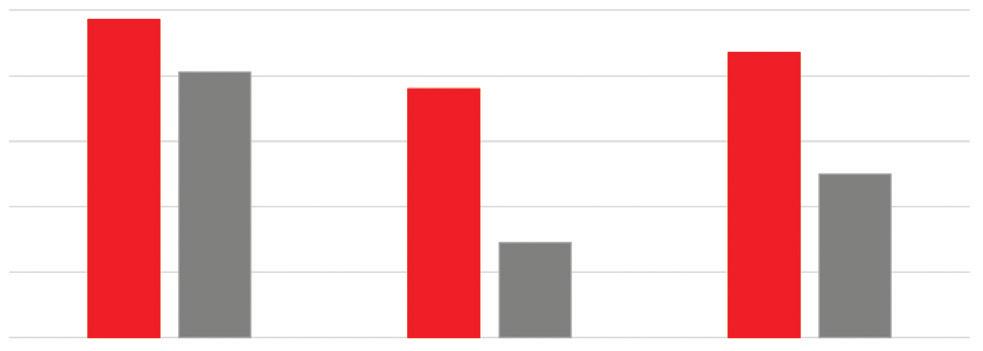
To take it a step further, we put ProfitSOURCE Angus-sired cattle head-to-head in the same pen as progeny of a competitor lineup. Datapoints from the feeding period and from the rail highlighted some key differences.
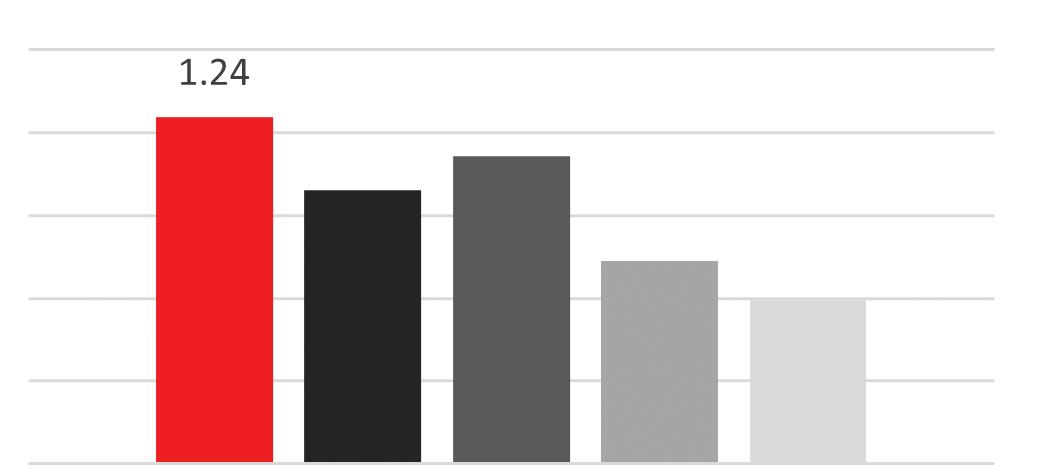
• ProfitSOURCE cattle showed slightly improved average daily gain on the feeding period, though not statistically significant (.3 lb./day over the entire 209 day feeding period).
• While ProfitSOURCE cattle were of slightly higher Yield Grade than the competitors, they more than made up for it with phenomenal marbling and carcass weight.
• ProfitSOURCE cattle had more than 10% less instances of liver abscess, a problem which has cost the entire beef industry more than $409 million in the last year. However, this is more likely attributed to the top-notch calf care provided at the source dairy –yet another hallmark of ProfitSOURCE-enrolled herds.
When all was said and done, we ran the carcass data through a few current, real packer grids. The ProfitSOURCE cattle brought $190 to $210 more per head than the competitor cattle. Profit, indeed!
When it comes to the rail, we know quality is king and that branded beef programs continue to desire more higher-grading carcassesconsumer demand for high-quality beef remains high and consistent.

From the genetics side, the Marbling EPD is the most heritable of all the carcass traits with a 44% H value, meaning we can influence performance heavily just by selecting for the trait. A 2022 review of available lineups showed the ProfitSOURCE Angus sires led the competition in average Marbling EPD. Our lineup continues to average within the top 10% of the breed for MARB. While management during the animal’s lifetime can set it up for success on the rail in Carcass Weight and Yield Grade, we can achieve Quality Grade simply through sire selection of our high-Marbling ProfitSOURCE sires.
*Hot Carcass Weight is with kidney, pelvic and heart fat (KPH) removed
Our sire lineup is carefully curated. While you may be drawn to sires meant for our native beef x beef market, because they meet your calving ease needs, stick to ProfitSOURCE sires. The lineup from ProfitSOURCE appropriately combines calving ease with impressive terminal performance. Whether marketing through a partner program or selling locally, these tagged BxD calves reflect their sires’ genetics. Traceability on these kinds of calves secures our relationship with calf buyers and partners for the long-term. Let’s keep them coming to encourage sustainable market access and higher pricing. u
11740 US 42 NORTH • PLAIN CITY • OHIO • 43064-0143
To enhance the productivity and profitability of dairy and beef producers, Select Sires is committed to be the premier provider of highly fertile, superior genetics accompanied by effective reproductive- and herdmanagement products and services
For more information, visit www.selectsires.com or call (614) 873-4683.

™Herd Health Profit Dollars and HHP$ are trademarks of Select Sires Inc. SimAngus is a trademark of the American Simmental Association. ®Your Success Our Passion., NxGEN, Mastitis ResistantPRO and ProfitSOURCE are registered trademarks of Select Sires Inc. Dairy Wellness Profit Index, DWP$ and CLARIFIDE are registered trademarks of Zoetis Inc., its affiliates and/or its licensors. TPI is a registered trademark of Holstein Association USA. All rights reserved. Buyer assumes all responsibility for use, storage and handling of herd management products. All claims, representations, and warranties, expressed or implied, are made only by the company responsible for manufacturing and not by Select Sires Inc., its member cooperatives, its agents or employees.
7 = Select Sires; 14 = Accelerated Genetics; 250 = GenerVations